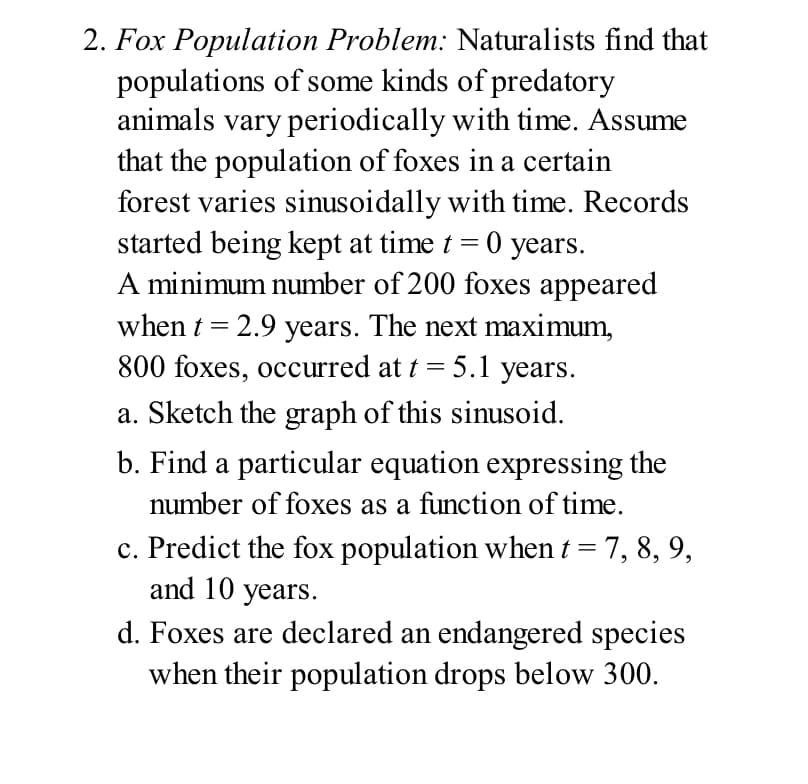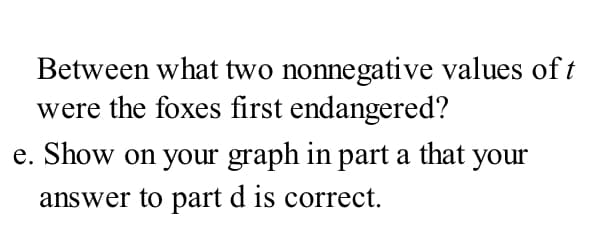Fox Population Problem: Naturalists find that populations of some kinds of predatory animals vary periodically with time. Assume that the population of foxes in a certain forest varies sinusoidally with time. Records started being kept at time t = 0 years. A minimum number of 200 foxes appeared when t = 2.9 years. The next maximum, 800 foxes, occurred at t = 5.1 years. %3D %3D a. Sketch the graph of this sinusoid. b. Find a particular equation expressing the number of foxes as a function of time. c. Predict the fox population when t = 7, 8, 9, and 10 years.
Fox Population Problem: Naturalists find that populations of some kinds of predatory animals vary periodically with time. Assume that the population of foxes in a certain forest varies sinusoidally with time. Records started being kept at time t = 0 years. A minimum number of 200 foxes appeared when t = 2.9 years. The next maximum, 800 foxes, occurred at t = 5.1 years. %3D %3D a. Sketch the graph of this sinusoid. b. Find a particular equation expressing the number of foxes as a function of time. c. Predict the fox population when t = 7, 8, 9, and 10 years.
Algebra & Trigonometry with Analytic Geometry
13th Edition
ISBN:9781133382119
Author:Swokowski
Publisher:Swokowski
Chapter6: The Trigonometric Functions
Section6.7: Applied Problems
Problem 68E
Related questions
Question

Transcribed Image Text:2. Fox Population Problem: Naturalists find that
populations of some kinds of predatory
animals vary periodically with time. Assume
that the population of foxes in a certain
forest varies sinusoidally with time. Records
started being kept at time t = 0 years.
A minimum number of 200 foxes appeared
when t = 2.9 years. The next maximum,
800 foxes, occurred at t = 5.1 years.
a. Sketch the graph of this sinusoid.
b. Find a particular equation expressing the
number of foxes as a function of time.
c. Predict the fox population when t = 7, 8, 9,
and 10 years.
d. Foxes are declared an endangered species
when their population drops below 300.

Transcribed Image Text:Between what two nonnegative values of t
were the foxes first endangered?
e. Show on your graph in part a that your
answer to part d is correct.
Expert Solution
This question has been solved!
Explore an expertly crafted, step-by-step solution for a thorough understanding of key concepts.
This is a popular solution!
Trending now
This is a popular solution!
Step by step
Solved in 4 steps with 1 images

Recommended textbooks for you

Algebra & Trigonometry with Analytic Geometry
Algebra
ISBN:
9781133382119
Author:
Swokowski
Publisher:
Cengage

Trigonometry (MindTap Course List)
Trigonometry
ISBN:
9781337278461
Author:
Ron Larson
Publisher:
Cengage Learning

Algebra & Trigonometry with Analytic Geometry
Algebra
ISBN:
9781133382119
Author:
Swokowski
Publisher:
Cengage

Trigonometry (MindTap Course List)
Trigonometry
ISBN:
9781337278461
Author:
Ron Larson
Publisher:
Cengage Learning